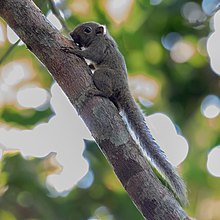Amazon Dwarf Squirrel
| Amazon Dwarf Squirrel | |
|---|---|

| |
| Научная классификация | |
| Домен: | Эукариота |
| Kingdom: | Animalia |
| Phylum: | Chordata |
| Class: | Mammalia |
| Order: | Rodentia |
| Family: | Sciuridae |
| Genus: | Microsciurus |
| Species: | M. flaviventer
|
| Binomial name | |
| Microsciurus flaviventer (J. E. Gray, 1867)
| |

| |
| Amazon dwarf squirrel range | |
Amazon Dwarf Squirrel ( Microsciurus flaviventer ) -это Suprmunk, родом из белка для дерева, родом из Южной Америки .
Описание
[ редактировать ]Как предполагает его название, белка Amazon-карлика относительно невелика, с длиной тела головы от 12 до 16 см (от 4,7 до 6,3 дюйма) и хвостом от 8 до 16 см (от 3,1 до 6,3 дюйма). Взрослые весят от 86 до 132 г (3,0 и 4,7 унции), а мужчины немного больше женщин. [ 2 ] Мех варьируется от красноватого до тусклого коричневого цвета, постепенно исчезая до желтого или серого на нижних частях. За ушами есть отличительный участок бледно -желтого меха, в то время как хвост имеет слабые желтоватые полосы и белая глазурь. [ 3 ]
The limbs are unusually long for tree squirrels. In the forelimbs, the humerus and radius are of equal length, an adaptation thought to increase the squirrel's ability to climb large trees, compensating for a lack of shoulder mobility. The longer hindlimbs allow for stronger muscles, so that the squirrel can leap over larger gaps, relative to its size, than more typically sized squirrels can.[3]
Distribution and habitat
[edit]The squirrels are found in the upper Amazon Basin, broadly west of the Purus and Rio Negro rivers, in Brazil, Bolivia, Peru, Ecuador, and Colombia. They typically inhabit evergreen tropical rainforests at up to 2,000 m (6,600 ft) elevation,[3] although they may sometimes be found in more disturbed habitats.[4]
Subspecies
[edit]Eight subspecies of Amazon dwarf squirrel are generally recognised.[5][3] Recent studies have indicated that the subspecies M. f. otinus, M. f. sabanillae, M. f. similis, and M. f. simonsi are their[6] own distinct species rather than subspecies. The same study also showed that M. f. otinus and M. f. similis are more closely related to Microsciurus mimulus and Sciurus pucheranii than they are to M. flaviventer.
| Subspecies | Authority | Synonyms | Distribution |
|---|---|---|---|
| M. f. flaviventer | Gray (1867) | manarius | Western Brazil, northeastern Peru |
| M. f. napi | Thomas (1900) | avunculus, florenciae | Northeastern Ecuador |
| M. f. otinus | Thomas (1901) | none | Western Colombia |
| M. f. peruanus | J. A. Allen (1897) | none | Northern Peru |
| M. f. rubrirostris | J. A. Allen (1914) | rubicollis | Southern Peru |
| M. f. sabanillae | Anthony (1922) | none | Southern Ecuador |
| M. f. similis | Nelson (1899) | none | Far western Colombia |
| M. f. simonsi | Thomas (1900) | none | Central eastern Ecuador |
Biology and behaviour
[edit]The squirrels use all levels of the forest, from the ground to the tree canopy, but are most commonly found in the understory. They feed on arthropods, tree bark, and fungi, and have been observed to closely follow flocks of birds while foraging, although the reason for this is unclear. They are diurnal and highly arboreal, even for tree squirrels, frequently jumping from branch to branch. They spend the night in nests formed from plant fibres, and located several metres above the ground.[3]
They are mostly solitary, but may be found with others feeding on the same tree. Their calls include a bird-like "trill" and a series of soft "chucks" used as an alarm call. Very little is known of their reproduction, although litters are thought to be small.[3]
References
[edit]- ^ Koprowski, J.; Roach, N. (2019). "Microsciurus flaviventer". IUCN Red List of Threatened Species. 2019: e.T13410A22255256. doi:10.2305/IUCN.UK.2019-1.RLTS.T13410A22255256.en. Retrieved 19 November 2021.
- ^ Hayssen, V. (August 2008). "Patterns of body and tail length and body mass in Sciuridae". Journal of Mammalogy. 89 (4): 852–873. doi:10.1644/07-MAMM-A-217.1.
- ^ Jump up to: a b c d e f Jessen, T.G.; et al. (August 2016). "Microsciurus flaviventer (Rodentia: Sciuridae)". Mammalian Species. 48 (935): 59–65. doi:10.1093/mspecies/sew006.
- ^ Mena, J.L. & Medellin, R.A. (January 2010). "Small mammal assemblages in a disturbed tropical landscape at Pozuzo, Peru". Mammalian Biology. 75 (1): 83–91. Bibcode:2010MamBi..75...83M. doi:10.1016/j.mambio.2009.08.006.
- ^ Thorington, R.W. Jr.; Hoffmann, R.S. (2005). "Microsciurus flaviventer". In Wilson, D.E.; Reeder, D.M (eds.). Mammal Species of the World: a taxonomic and geographic reference (3rd ed.). The Johns Hopkins University Press. pp. 754–818. ISBN 0-8018-8221-4. OCLC 26158608.
- ^ de Abreu-Jr., E. F.; Pavan, S. E.; Tsuchiya, M. T. N.; Wilson, D. E.; Percequillo, A. R.; Maldonado, J. E. (26 June 2020). "Museomics of tree squirrels: a dense taxon sampling of mitogenomes reveals hidden diversity, phenotypic convergence, and the need of a taxonomic overhaul". BMC Evolutionary Biology. 20 (77): 77. Bibcode:2020BMCEE..20...77D. doi:10.1186/s12862-020-01639-y. PMC 7320592. PMID 32590930.
Bibliography
[edit]- Тирира, Диего. 2006. Млекопитающие Эквадора, разнообразие: Microsciurus flaviventer (Grey, 1867). Страница в Интернете (январь 2006 г.). Версия 1.1. Белые биты. Кито Машифры проверенной на экваторе: дата посещения (2009-03-17)



